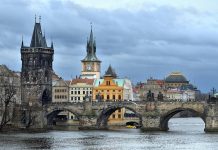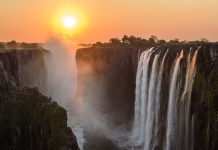For the most part, Mongolia consists of a plateau that is broken up by mountain ranges. The plateau ranges from 900 to 1,500 meters in height (3,000 – 5,000 ft), while the Altay Mountains , found in southwest Mongolia reach above 4,000 meters. In central and southeast Mongolia , the Gobi Desert can be found.
Mongolia’ s forests are filled with pine, larch and cedar trees, which can be found in the mountains. Other natural resources to be found are minerals such as copper, iron, fluorspar, gold, silver, uranium, coal and iron.
Mongolia has an extreme climate with temperatures varying greatly with the seasons. In the summer, the temperature ranges from 10 – 20 degrees C (50 – 80 degrees F); while in the winter the highs tend to be about -21 degrees C, with lows of -30 degrees C (-5 to -22 degrees F). The summers in Mongolia tend to have about 15 inches of rain (380 mm), excluding the desert, while the winters are typically without precipitation.
Due to the large number of animals with fur, including the marmot and the squirrel, Mongolia has a strong fur trade. Other animals to be found are sheep, goats, horses, camels and cattle, although they can usually be found in the prairies in the northeast and northwest. These animals are usually raised by the Mongolians, as agriculture is their main way of life.
During the 15th century, Mongolia was torn apart with dissension and strife. With the rise of Tibetan Buddhism in the 16th century, a Living Buddha would be named. It was the son of the Mongol khan of Urga ( Ulaanbaatar ). Although the Qing Dynasty had dominion over Mongolia , the ruling groups of the country were the Buddhists and the Mongol aristocracy who were allies at this time.
When Mongolia declared it’s independence from China during the 1911 Chinese revolution, the Living Buddha still ruled. By 1920, a puppet government was established by a Russian general but the next year the Mongolian People’s Revolutionary Party began a government, with help from Russian Communists, that usurped the general and those who supported him. When the last Living Buddha died in 1924, the Mongolian People’s Republic was established, but was not recognized by China until 1946. Due to Mongolia’ s alliance with Russia , when China separated itself from Russia , trade relations were greatly reduced between China and Mongolia . Russia’ s influence in Mongolia remained strong through the 1990’s.
In January 1992, a new constitution was instituted by Ponsalmaagiyn Ochirbat , Mongolia’ s president. In 1993, a new treaty was signed by Boris Yeltsin, Russia’ s president and Ochirbat, and that same year Ochirbat was reelected as president. With all the changes involved with reforming to a free-market system, the economy floundered. High inflation and unemployment caused President Ochirbat to lose the 1997 election to Natsaglin Bagabandi. Bagabandi had promised slower economic reforms and increased social services.











